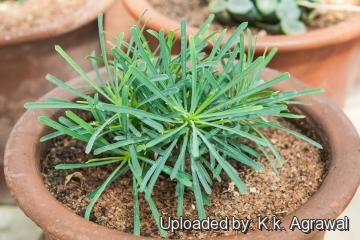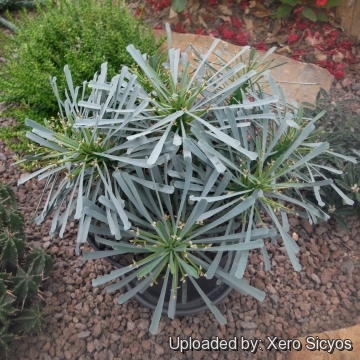




Your support is critical to our success.

Origin and Habitat: Klein and Groot Swartberg ranges between Laingsburg, Ladismith and Prince Albert in the southern Karoo. Western Cape, South Africa. Extent of occurrence 1768 km², five known subpopulations, but there could be more as the habitat is generally quite inaccessible.
Habitat and Ecology: It is locally abundant among shrubs in Nama Karoo and Succulent Karoo. It prefers higher altitudes (up to 900 metres a.s.l.) and is usually found on mountain slopes, steep cliffs and summits, on sandstone or shale rocks together with Senecio haworthiiSN|27697]]SN|27697]]. The plants may or may not shed their leaves during the hot summer. Individuals on lower slopes could be collected but the majority of individuals occur on inaccessible cliffs and are therefore not threatened.
Synonyms:
- Euphorbia multifolia A.C.White, R.A.Dyer & B.Sloane
ENGLISH: Cushion Milkspurge, Hedgehog
AFRIKAANS (Afrikaans): Ystervarkpol, Doringpol, Ystervark
Description: Euphorbia multifolia is a spineless perennial succulent-shrub, forming a green, raised leafy cushion up to 15(-30) cm hight. During drought it can lose its leaves - otherwise it is mostly evergreen.
Stems: The short succulent trunk forms numerous curved stems up to 13 cm and more long, 25 -30 mm thick, subcylindrical, with small lateral, crowded, secondary branches densely covered with tubercles and persisting.
Leaves: Green, very narrow, up to 40 mm in length and strongly folded.
Similar species: This species is very similar and often is confused for the related Euphorbia eustacei. Potted plants differ mostly in the shape of the leaves. Leaves of E. multifolia are more narrow, more strongly bent and seem trimmed.
Bibliography: Major references and further lectures.
1) Urs Eggli “Illustrated Handbook of Succulent Plants: Dicotyledons” Springer Science & Business Media, 2002
2) Doreen Court “Succulent Flora of Southern Africa” CRC Press, 01/Jun/2000
3) David Hardy, Anita Fabian, Gerrit Germishuizen “Succulents of the Transvaal” Southern Book Publishers, 1992
4) Alain Campbell White, Robert Allen Dyer, Boyd L. Sloane “The succelent Euphorbisae (southern Africa)” Abbey garden press, 1941
5) Hermann Jacobsen “Abromeitiella to Euphorbia” Blandford Press, 1960
6) Goldblatt, P. and Manning, J.C. 2000. "Cape Plants: A conspectus of the Cape Flora of South Africa" Strelitzia 9. National Botanical Institute, Cape Town.
7) Hilton-Taylor, C. "Red data list of southern African plants.” Strelitzia 4. South African National Botanical Institute, Pretoria. 1996
8) Raimondo, D., von Staden, L., Foden, W., Victor, J.E., Helme, N.A., Turner, R.C., Kamundi, D.A. and Manyama, P.A. “Red List of South African Plants.” Strelitzia 25. South African National Biodiversity Institute, Pretoria.2009
9) Vlok, J.H. & Raimondo, D. 2007. Euphorbia multifolia A.C.White, R.A.Dyer & B.Sloane. National Assessment: Red List of South African Plants version 2014.1. Accessed on 2014/07/31

Euphorbia multifolia Photo by: K.k. Agrawal

Euphorbia multifolia Photo by: Xero Sicyos
Cultivation and Propagation: Euphorbia multifoliaSN|28256]]SN|28256]] is an easy to grow plant for pot culture.
Growth rate: It is a relatively rapidly growing species that will make large clumps whit hundreds heads given the best conditions.
Soil: It grows well in a very draining mineral potting substrate, but it isn't picky about soil.
Repotting: Use pot with good drainage.
Watering: During the summer they enjoy average watering, but do not overwater (Rot prone), keep dry in winter.
Fertilization: Feed with a high potassium fertilizer in summer.
Hardiness: When dormant in winter, keep it totally dry at or around 4°C, even though it seems to tolerate light frosts well.
Exposure: They do need a lot of light to keep their compact growth-form. They get a rich purple tinge if grown in full sun, however some protection in light shade is recommended during the hottest hours in summer.
Uses: It is an excellent plant for container growing. It always looks good and stays small. It looks fine in a cold greenhouse and frame.
Warning: As with all other Euphorbias when a plant get damaged it exudes a thick white milky sap known as latex. This latex is poisonous, and may irritate skin. Pay extreme attention not to get any in your eyes or mouth.
Cultivated plants must be handled carefully.
Rot: Rot it is only a minor problem with Euphorbias if the plants are watered and “aired” correctly. If they are not, fungicides won't help all that much.
Propagation: It is propagated by cuttings (It branches enthusiastically, and offsets are readily available). If you remove an offset, remember to let it dry for some days, letting the wound heal (cuttings planted too soon easily rot before they can grow roots). Lay it on the soil and insert the stem end partially into the substrate. Try to keep the cutting somewhat upright so that the roots are able to grow downward. It is better to wash the cut to remove the latex.
| Your Actions | |
|---|---|
| Back to Euphorbia index | |
| Back to Euphorbiaceae index | |
 |
Back to Succulents Encyclopedia index |
Privacy stantement - Terms and conditions - How to cite - About us - Feedback - Donate



